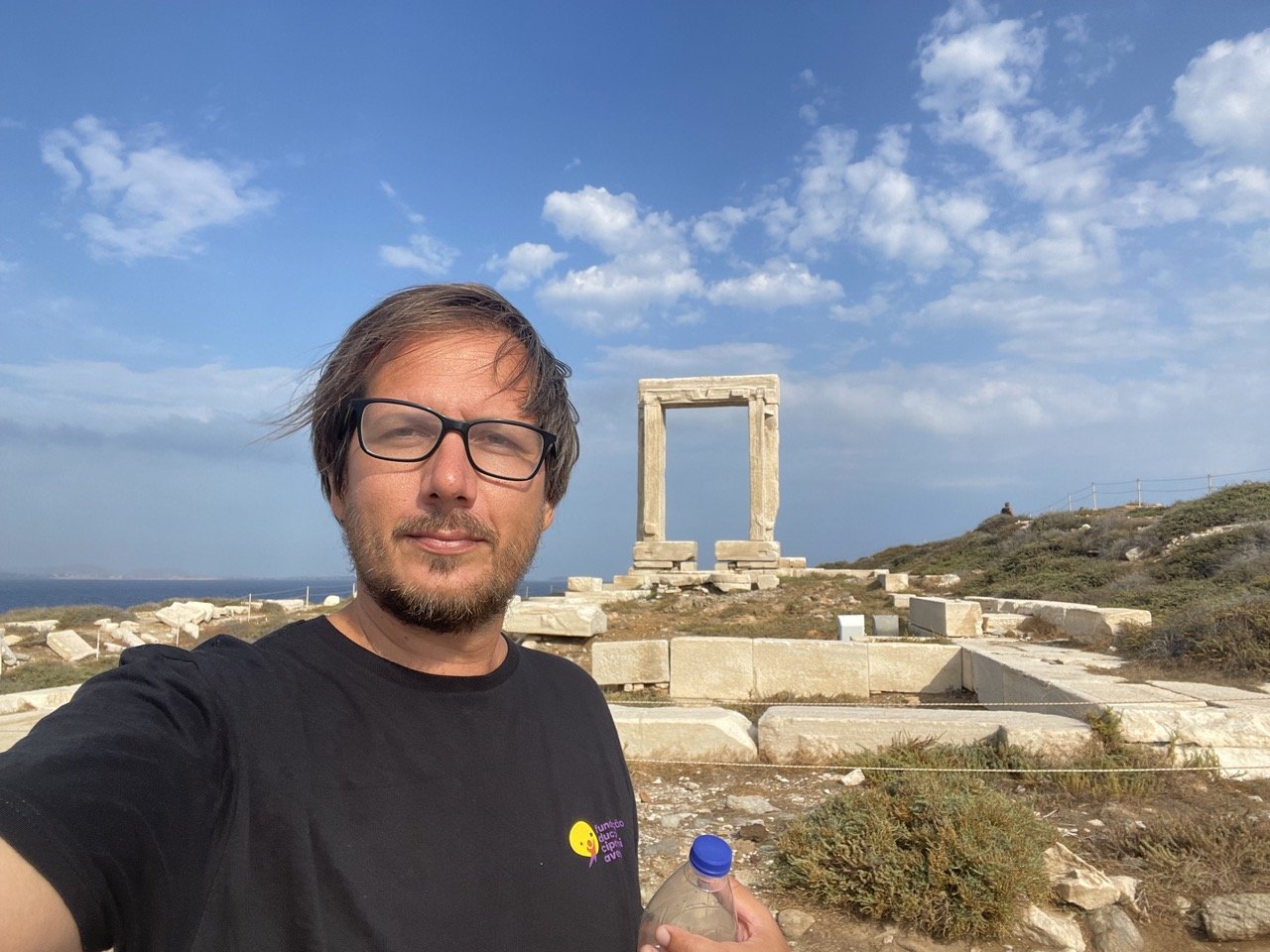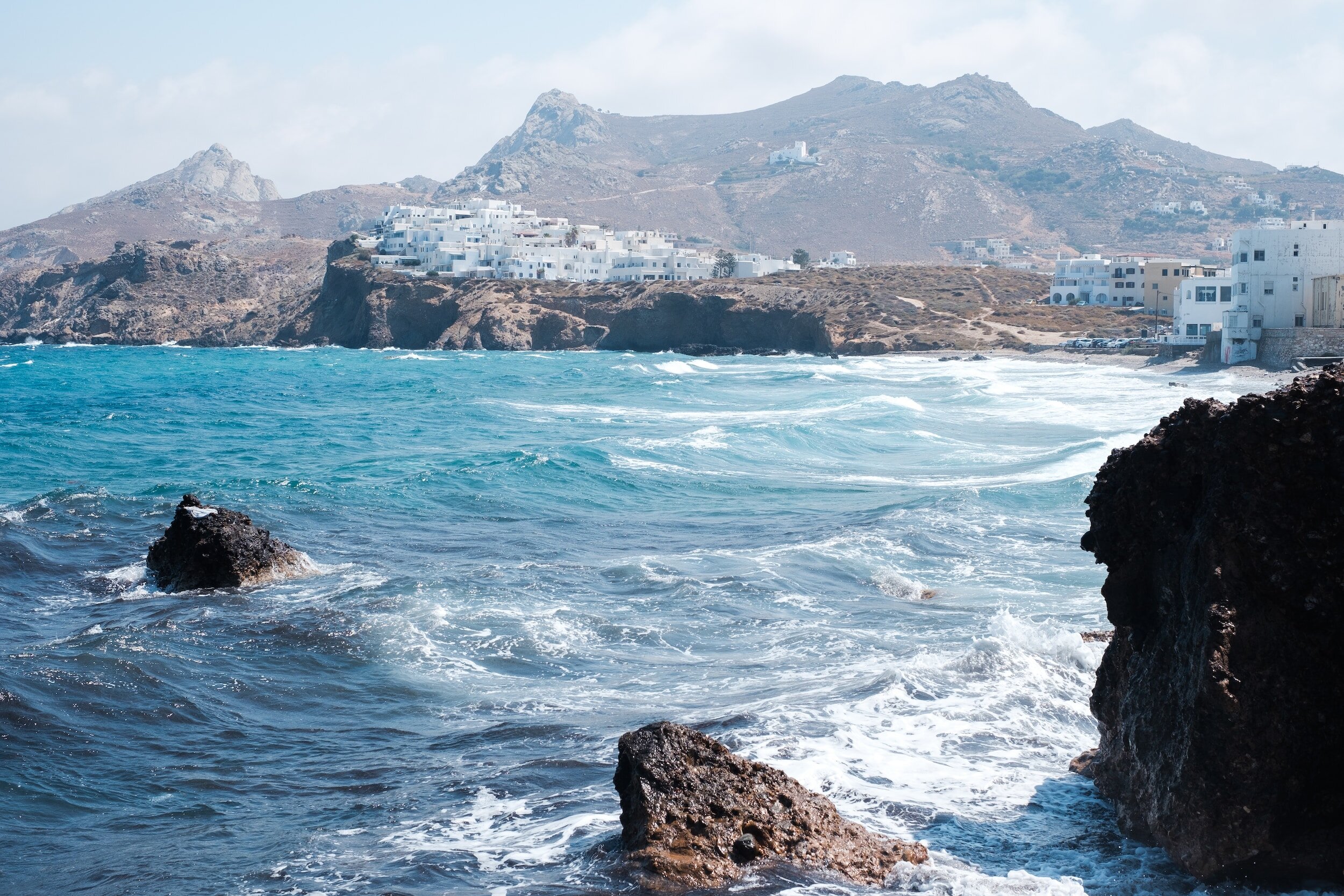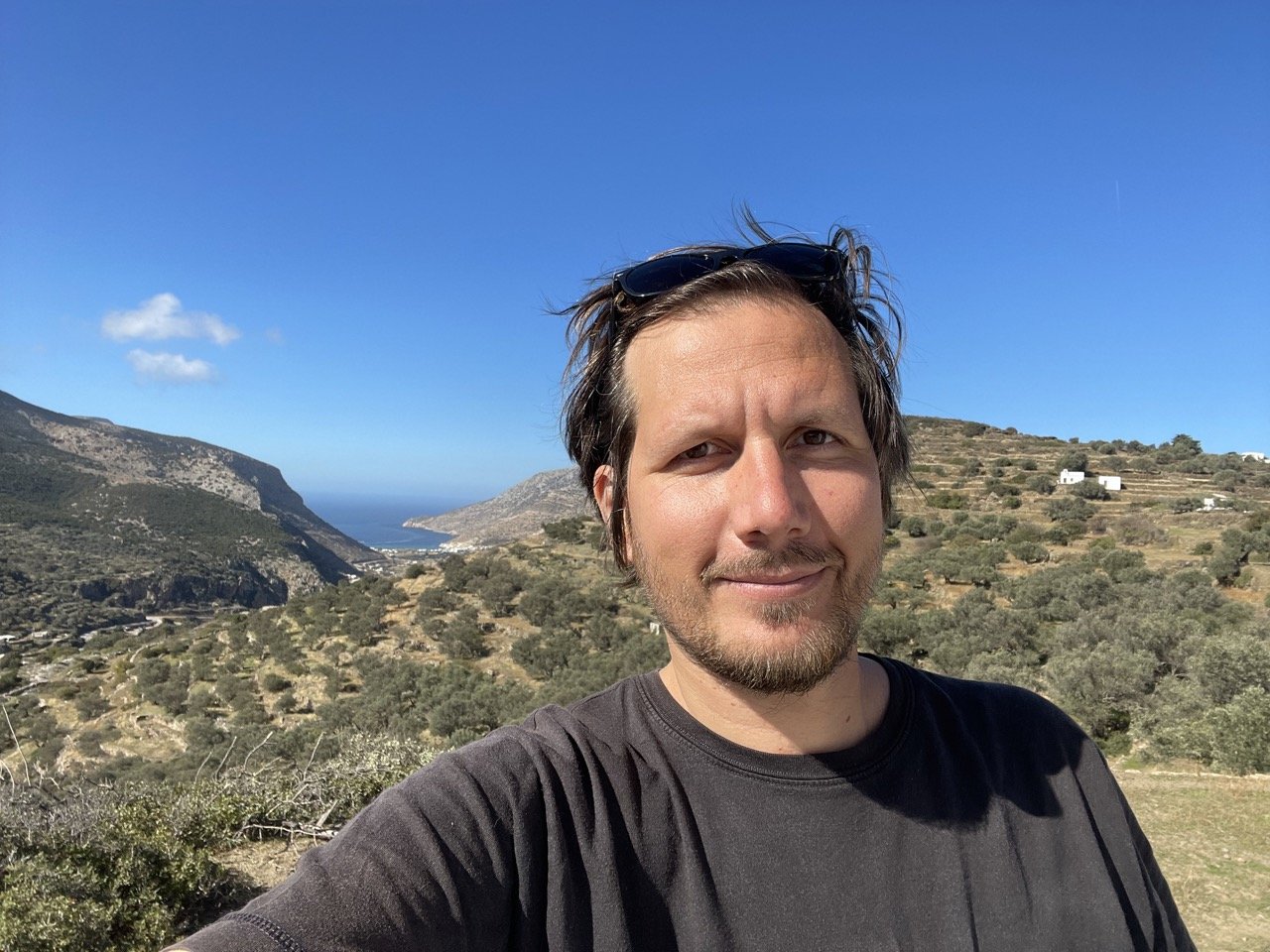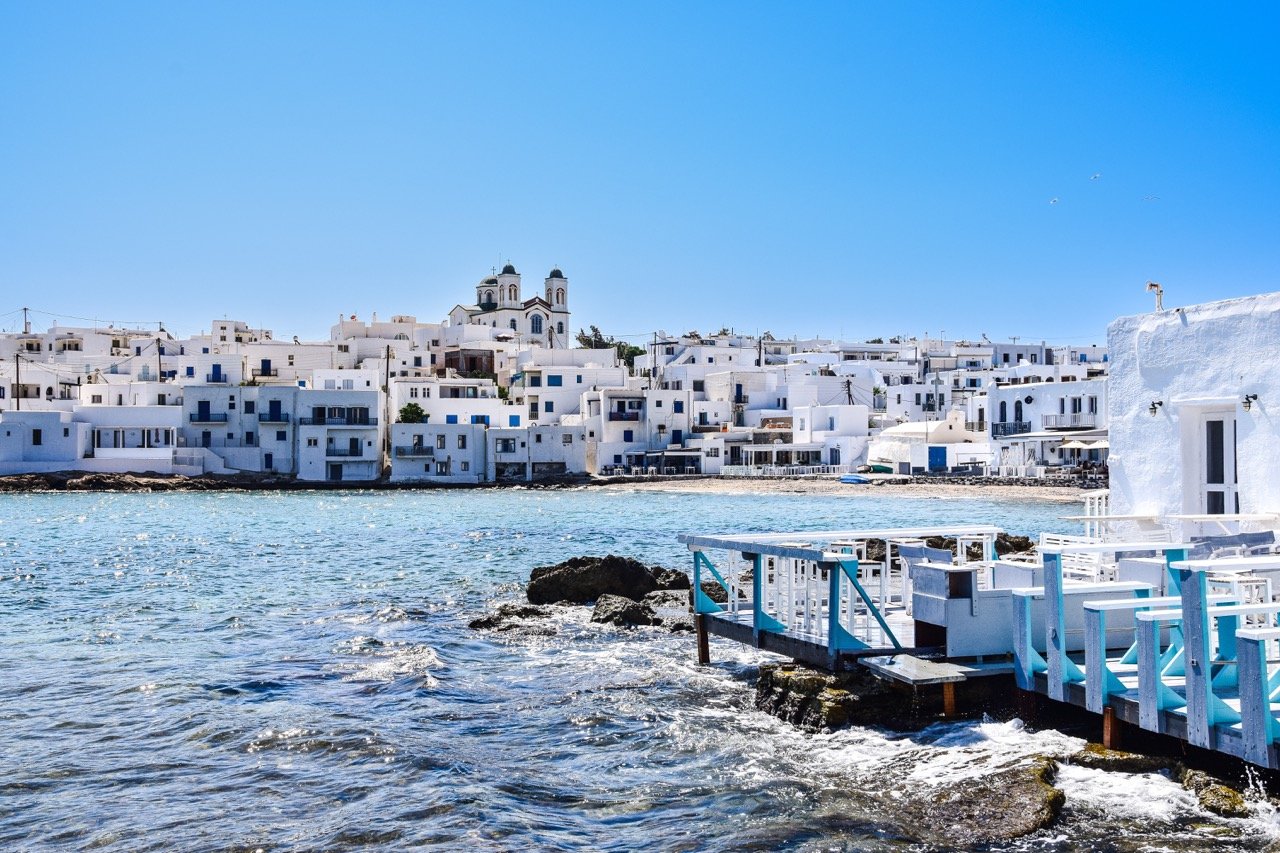A Local’s Guide to Visiting Paros, Greece
Affiliate disclosure: some of the links in this article are affiliate links. If you book using one of them, we’ll earn a small commission. All of our info is free to read and free of ads, so we appreciate it!
World renowned since ancient times for its translucent white Parian marble (used in the exquisite Venus of Milo statue on view at the Louvre), Paros today is one of Greece’s most popular holiday islands.
Thanks to its 44 beautiful beaches, fashionable beach clubs, buzzing nightlife, world class windsurfing and water sports, and prices still within even most backpackers’ budgets, this is an island thoroughly worth visiting for just about anyone.
Paros’s capital city (and port) Parikia has a pretty Cycladic historic centre, as does the island’s second main town, the tourist hub of Naoussa, a former fishing village that’s become the cocktail lounge capital of the Aegean.
Older villages are scattered across its gently rolling landscape, providing visitors with plenty of places to visit should they tire of the beach. Paros’s wines also have a growing reputation, and there are a number of excellent vineyards that offer tours and tastings.
And, in a welcome trend, Paros is one of few islands in Greece that has gotten serious about reducing waste, making it an interesting destination from an eco standpoint.
Table of Contents
Plan your itinerary with local help
If you could use some help figuring out your plan for visiting the Greek islands, schedule a Greece travel consultation with Luca, our Sifnos-based Local Expert!
These are one-hour Zoom calls where you’ll get to chat with Luca about the trip you’re planning and he’ll share his tips and advice, answer your travel questions, and help you perfect your itinerary.
Where is Paros
Photo: User: Bgabel at wikivoyage shared, CC BY-SA 3.0, via Wikimedia Commons
Paros is right near the centre of the Cyclades archipelago, about 170km or 90 nautical miles south of Athens. The nearest islands are Naxos, just to the east, and Antiparos, to the west.
Why visit
Paros’s lovely sandy beaches, water sports, and nightlife, along with its pretty Cycladic villages provide ample reason to visit. There aren’t many specific must-see sites or towns on the island, but young people especially like it for its fun, laid-back vibe, and prices that are much friendlier than those on its rival Mykonos.
Paros mostly appeals to families, couples, and young backpackers, due to its its vast range of accommodation, restaurants, and nightlife. If you like peace and quiet in the summer, or are in search of cultural and important archaeological sites, you probably won’t want to linger too long here though.
What is Paros known for
Paros is famous for its golden beaches: every coast has its share, and most are well equipped with bars, tavernas, water sports, sun beds and beach clubs, many playing the latest hits throughout the day. It’s also known for the Meltemi wind in summer, which keeps temperatures relatively cool and delights the windsurfers (although it can occasionally cause havoc with ferry schedules).
The historic core of the island’s capital, Parikia, is a Cycladic delight, and one of the few towns without a lot of steps and steep streets. Beyond its landmark windmill, its maze-like heart holds a Venetian castle (Kastro), a remarkable monument almost entirely made of columns and blocks cannibalized from a pair of marble temples.
Parikia is also famous for one of the oldest churches in Greece: Panagia Ekatontapyliani, Our Lady of a Hundred Doors, a majestic 6th century basilica built under the Byzantine emperor Justinian.
The pretty town of Naoussa in the north with its perfect fishing harbour and half submerged Venetian castle is the other major tourist centre. It has beautiful beaches within walking distance of town, and other fabulous ones reachable by water taxis. These same taxis can also take you to the pleasant Paros Park nature reserve on the island’s far northwestern tip.
Some of the best windsurfing beaches in all Greece - Chryssi Akti (‘Golden Beach’) and Nea Chryssi Akti - are found on the island’s southeast. Calmer beaches such as Aliki and Faranga are to the south, while the town of Pounta on the west coast is a small port and beach resort, serving as the departure point for day cruises to the nearby island of Antiparos and the fascinating desert islets even further south.
Inland, along with the ancient marble quarries on the slopes of 2,530ft Mount Profitis Ilias, Paros’s highest point, there are vineyards, olive groves, and small farms, along with a handful of pretty whitewashed villages that offer a peaceful change of pace from the busy beaches.
Two of the oldest villages, Lefkes and Prodromos, are linked by a rare 1000-year old Byzantine road, now one of several beautiful walking trails on the island. The lushest corner on Paros, between Parikia and Pounta, is a butterfly nature reserve.


How to get here
Arriving by plane
Paros has a small airport, offering at least 3 daily flights to Athens. Flights take 40 minutes and cost as little as $35 one way in low season, rising to $100+ in summer. Starting in April, there are also direct flights from Thessaloniki, which take 75 minutes. Within the Greek islands, you can fly into Paros from Astypalaia, Heraklion (in Crete), Syros, and Milos.
Paros’ airport runway is currently being extended to accommodate larger planes, meaning that flights from around Europe will soon be able to land here, possible by sometime in 2024, in which case there will be many more air connections.
Until then, unless you’ve found a convenient flight from one of the destinations already mentioned, it’s often most convenient to fly into Mykonos (which is connected with countless European airports) and then catch a ferry from there on to Paros.
Arriving by ferry
If flying isn’t convenient or you’d simply prefer not to, there are daily ferries from Piraeus, the port of Athens, to Paros. The journey takes 3.5 to 4 hours by high-speed ferry and one way tickets start at $80.
From June to late September, you can also catch ferries in Rafina in western Attica (which has bus connections with Athens Airport). The trip takes about the same amount of time as from Piraeus, and ticket prices are similar.
No matter where you sail from, the general rule is that you pay more for speed: high-speed Sea Jet tickets cost at least 50% more than the slower ferries. Note that the earlier you book your ticket, the cheaper the fare will be.
Where to book ferry tickets
To check schedules and prices, I recommend using Ferry Scanner which is an aggregator that shows options from a bunch of different ferry companies. Their schedules are always up to date, it’s easy to use, and the price difference between using them and booking direct is negligible.
Main connecting ports
From Mykonos Ferries to Paros take about an hour and cost around $60; Seajets travel six or more times a day in the summer, take 40 minutes and cost around $65.
From Santorini Ferries sail this route in 2 hours, once a day from late March to mid-October. One way tickets start at $64.
From Naxos Direct links between Naxos and Paros are available almost daily in high season; the crossing takes just under 2 hours and costs around $35.
Transportation and getting around
Paros covers a land area of about 75 square miles, and the island has decent bus service covering it. There are 15 buses plying routes to all the major villages and beach resorts from the capital, Parikia, on the northwest coast. There are also regular buses to the airport, which is 11km south of Parikia.
The longest bus ride, from Parikia to Chryssi Akti (Golden Beach), on the southeast coast, takes just under an hour. One-way tickets cost $2 if purchased at the bus stations in Parikia or Naussa, or at some mini-markets. Tickets can be purchased from the driver on board the bus, but will be slightly more expensive.
In summer, buses tend to fill up fast, so you’ll want to arrive to the station a little bit ahead of time to be sure to get a seat.
If you are just spending two or three days on the island or mostly plan to hang out on the beach, you probably won’t need a car. However, if you want to explore, there are numerous places to hire a car, motorbike or ATV, although it’s essential to book one well in advance in summer to avoid disappointment.
Where to find a car rental
Try Rigas (which also has automatics); Stefanos in Parikia rents out scooters and cars; Motor Land offers cars, scooters and ATVs. Summon a radio taxi at +30 694 413 8995 or +694 454 0556.
I also always recommend checking prices on DiscoverCars. It’s a car rental aggregator website that includes offerings from all the major international rental companies as well as lots of smaller local agencies, which often have much better pricing. You can find great deals.
When to visit
The best time to visit Paros is in the spring (May if you want to be able to swim) or in the fall; late September and October being ideal. In both periods, everything on the island is open, getting here and getting around is easy, prices are reasonable, and the madness of summer is absent.
Visiting in Spring
Paros is impressively green in the early spring, but by June the hills will have all turned a golden brown. Generally, the island begins to open up for tourism around Greek Easter, usually in April or early May.
By that time, it’s perfect for long days outside, as the weather will be warm, but not yet hot enough to be unpleasant. By May it should be warm enough for a dip in the sea.
Most visitors in the spring are couples or young families with small children.
Visiting in Summer
The summer is when Paros really comes into its own and this is the peak season for travel on the island. July and August are often very hot, but nights are perfect for sitting out late into the evening, eating long dinners, drinking, and chatting with friends.
Be aware that prices are at their highest during this time, and you need to book hotel rooms, restaurants, and even sun beds in advance.
This is also the time of the biggest festivals: in late June, the towns of Aliki, Naoussa, and Prodromos celebrate the Klidonas, a festival in honor of St. John. This is a time of feasting, dancing and leaping over bonfires. On the 15th of August, Parikia celebrates the Monastery of Panagia Ekatontapyliani with a large procession through town.
The exciting Barbarossa Pirate Festival in Naoussa takes place on 23 August, with reenactments of a pirate raid and plenty of fireworks. Finally, the Paros Park festival runs all throughout the summer, with regular concerts, theatre shows, and dance performances.
Visiting in Fall
In September and early October, the crowds have dispersed and things have calmed down, but the weather is still warm and very pleasant. This is the perfect time to enjoy the beaches in relative peace, or go for walks, hikes, and bike rides.

How many days to spend
Four days is enough to give you a taste of what Paros has to offer, although beach lovers and windsurfers may want to spend their whole vacation on the island. Assuming you opt for four days though, here’s how I’d suggest spending your time:
Set aside a day to explore Parikia and a nearby beach. Dedicate your second day to visiting Naoussa, with its beaches, and then Paros Park.
Next, take a full-day cruise leaving from Pounta. On your final day on the island, i’d suggest heading inland, to check out villages, go hiking, and visit some vineyard and olive groves.
If you have more time, a week to ten days would give you ample opportunity to check out almost every beach, visit the coastal and inland towns & villages, do all sorts of activities (boat trips, hiking, vineyard/gastronomic tours, etc.), and sample just about all the bars and restaurants on the island.
Where to stay
Accommodation on Paros ranges from luxurious villas and hip resorts to budget friendly pensions, apartments, studios and campgrounds. If you want to be near the nightlife, stay in Parikia or Naoussa, both of which are also in walking distance of beaches.
Nea Chryssi Akti offers great access to beautiful beaches along with a few bars and restaurants that stay open after dark, while Aliki, also near to fabulous beaches, is sleepier.
If you really want peace and quiet and don’t have to be near a beach, there are options (mainly villas and Airbnbs) isolated in the countryside or near the inland villages, although you will need a car if you choose to stay there.
Parikia
Parikia is a good base for visiting the rest of Paros by bus. Most of the hotels are located in the newer parts of town, especially along the beach and bay north of the historic centre. Many are in walking distance of the ferry dock.
The cool and contemporary Sandom Hotel ($150) is central and serves a great breakfast.
If you have a car, the recently renovated and moderately priced Paros Five Senses ($125) is in a quiet seaside setting between Parikia and the airport.
Done with pretty, typical Cycladic-style Hotel Dina ($60) in the heart of the old town is a 10-minute walk from Livadia beach and a great budget choice.
Naoussa
Fashionable Naoussa in the north has a dense concentration of boutique hotels and suites, most of which are near the small beaches, with a 20 minute walk of the picturesque old fishing port in the center of all the cocktail swilling action after dark.
Taxi boats will take you to Paros Park with its outdoor theater, beach and beach club.
Parocks Hotel ($400) is a stylish boutique choice by Ampelas beach, with a spa and good restaurant.
Most of the suites, rooms, and apartments in the chic Hotel Senia ($250) overlook the sea and Piperi beach, a short walk from Naoussa.
The immaculate family-run Parian Lithos Residence ($175) is in walking distance of all the fun.
Blue Aura Camping on the beach is a ten minute walk west of Naoussa.
Nea Chryssi Akti
If you’re on Paros for the wind and water sports, you can’t beat the Golden Beaches - Nea Chryssi Akti or Chryssi Akt--on the southeast coast, where you will be surrounded by like-minded souls. It’s not too lively after dark, but there are always tavernas and bars that stay open until late.
Water sport fans will love the Saint George Hotel ($130) just off the beach, with wonderful views and a big pool.
Boudari Hotel, Suites & Bungalows ($125) is ideal for families, with all kinds of room combinations, a pool, spa and a tasty Greek breakfast.
Aliki
If you prefer a quieter sleep, look to the southeast beach resorts at Aliki or Faragas, which are popular with older couples and families, places that rarely get too noisy after dark.
Afrodite ($150) is a tidy little hotel with a pool and friendly staff, with family rooms, a short walk from the child-friendly beach.

Luca's got answers!
Connect with our Greece-based travel experts for insider advice, local tips, and help planning a better trip!
Things to do
1. Flit in the wind
Paros has some of the gustiest beaches in the Aegean, including Blue Flag Nea Chryssi Akti in the southeast, the site of annual Professional Windsurfers events. Paros Kite offers windsurf boards, kitesurfs and Wing Foil rentals and lessons.
2. Discover ancient marbles
The Archaeology Museum of Paros in Parikia has an exceptional collection of artefacts, including a section of the famous Parian Chronicles discovered in 1960, with the history of Greece from 1500—264 BC inscribed on marble tablets.
3. Visit the butterflies
The butterflies are actually black and yellow Jersey tiger moths that show their bright red underwings in flight. From June to August they swarm in a woodland nature reserve south of Parikia.
4. Sip the local wines
Located near Agioi Anargyri beach in Naoussa, the Moraitis Estate, now in the hands of the fourth generation of wine makers, produces some of the island’s finest PDO (Protected Designation of Origin) red, white and rosé wines, including the indigenous Thapsana varietal. Visitors are welcome in summer but do ring ahead.
5. Go to church
Not many churches from the 6th century survive in such good condition as the Panagia Ekatontapyliani in Parikia, modeled after an ancient Roman basilica.
The original church on the site was founded in 326 AD by St Helen, the mother of the Emperor Constantine, as she returned to Rome from her pilgrimage to the Holy Land; today it’s one of the most important pilgrimage sites on the Greek island.
6. Walk the Byzantine Road
See a different side of Paros on this 3.5km road paved in the 11th century, linking the charming inland villages of Lefkas and Prodromos, each with convenient bus stops.
Another nearby village, Marpissa has a Folklore Museum and the pretty house with the Pink Door that starred on Instagram.
7. Dance all afternoon
On the east coast of Paros, the uber-popular Punda Coast Beach Club has a DJ, salt water pool, and party vibe, especially on weekends.
8. Take a cruise
In summer, several daily cruises (among them Captain Ben and Sparos) depart from Pounta in southwestern Paros for a day long tour with lunch that includes the spectacular sea caves and Faneromeni beach on Antiparos, the Blue Lagoon (nicknamed the ‘Caribbean of the Aegean’) of the Panteronissia islets and a beach on the desert islet of Despotiko, where archaeologists are reconstructing a large temple of Apollo.
9. Gallop through the waves
Based in Kakapetra south of Paroika, Paros Horse & Donkey Rides & Tours offer a sunrise swimming with horses tour, a morning landscape ride, and a sunset tour, as well as donkey rides to the Butterfly reserve.
10. Tour an organic farm
Book ahead to visit Kamarantho, an organic permaculture farm in Kamari, founded on degraded soil in 2013 and now an inspiring agriculture success story on Paros, producing high quality olive oil, fruits and herbs.
11. Cycle around the island
Two companies, Oiconomakis Cycles in Parikia and Paros Cycling in Aliki, have road, mountain, and e-bikes to rent and offer various guided tours around the island, from easy to difficult, supplying everything you need.
Best beaches in Paros
To avoid disappointment at the beach clubs in July and August, be sure to book your sunbed in advance, if you want one. You can also plop on a towel in the sand.
Kolymbithres
West of Naoussa, this is the most striking beach on Paros, where mini sandy coves are nestled between fantastically eroded granite formations—only two are spacious enough for beach bars. Behind it you can hike up to Koukounaries to see the 12th-century BC ruins of a Mycenaean acropolis.
Chryssi Akti (Golden Beach)
Much loved for two thirds of a mile of extremely soft golden sand gently shelving into azure water, this beach is partially organized, but can get windy. The big news here is the Rebel Beach Club, with affordable sunbeds, good cocktails and every kind of water sport.
Monastiri
Northwest of Naoussa, at the entrance to the Paros Park nature reserve, this beach enjoys one of the most beautiful settings on the island, and with a chic beach club and the little outdoor Cinema Enastron that shows free films most summer nights.
The rest of the Paros Park is crisscrossed by several trails that take in some of its unique geological features. Water taxis provide transport from Naoussa.
Aliki
On the southwest coast, this peaceful, partly organized beach is sheltered from the winds, making it a good best for families with small children.
Molos
If you prefer your beaches music-free, sandy Molos with its warm water on the east coast is the place to chill, with a little windsurf rental place with a few sun beds and nothing else.



Connect with a Greece travel expert





















